You are very likely familiar with disclosures, which are legal statements that disclose a certain fact, like that you are writing a blog to be financially compensated or something similar. What about a disclaimer, and should your blog have one?
A disclaimer is a statement that can help you by preventing any future legal disputes or prosecution you might encounter. Basically, it is there to state that the writing or points of view are personal and that they belong to the author of a particular piece, they are not in any way an authentic representation of what your blog stands for.
In the following article, we will discuss why your blog needs a disclaimer and what should be included in the disclaimer. Afterward, we’ll move onto how to add a disclaimer in your WordPress blog step by step and finish up with some examples for you to get the gist of what was discussed here.
Table of Contents
PRO TIP: Take the hassle of writing your own disclaimer away with our disclaimer generator trusted by over 200,000 businesses. It’ll save you hours of work and possible costly legal mistakes.
Why does your blog need a disclaimer?
The simple answer is, you will likely get sued without a disclaimer, and it’s really absurd to end up with a lawsuit just because you didn’t include one simple page on your blog. However, let’s examine this topic a bit further to see why it is so important.
Let’s start with an example. If you are a blogger, you are very likely not in it simply to share quality information through your content, which took hours, days, or even weeks to prepare – you are blogging most likely to make a living.
So, people who want to sell their product will contact you and offer you payment for writing a review for it, in an attempt to increase their sales rate. Considering how you are writing for money, and how your reviews need to glorify the product, there is little point in trying it out and experimenting, you’ll just write a compelling piece and get paid.
However, you cannot take every single person who reads the blog into account, and people have different allergies, different metabolisms, basically not only do we have different opinions, we are also different on a biological level.
Since it is possible that someone who listens to your review does not have the same experience with the product that you promised, they are allowed to sue you, since you earn money from advertising on your website. In other words, you get to be held responsible just because you do not have a disclaimer.

A disclaimer is like a miracle armor in this case, as it states that the reader is using or buying a product you promote on his own free will and at his own risk.
It is especially crucial that you have a disclaimer if you write guides, instructions, or “how-to” articles, considering just how many things can go wrong if you are held responsible for the user’s action.
However, this is much easier said than done, because when it comes to legislation you need to be really specific with what you cover to avoid potential loopholes. This will be elaborated more thoroughly in the next section when we explain what you should include in your blog disclaimer.
What to include in a blog disclaimer?
The priority, in this case, is to supply the readers with clear and not in any way ambiguous information regarding the content on your blog. You need to tell them not to rely on your blog content, and if they do you are not to be held liable.
Moreover, it is imperative you state that you are not making promises, or guarantees regarding the accuracy of information supplied, nor that you guarantee for the completeness of the information found on your blog.
In other words, your blog content is not a replacement for advice they would receive from a licensed professional.
Here are some other things you should also include in your blog disclaimer:

Nature of your website
It is important that a clear distinction is made between a website and a blog. A website has more permanent content, in a way, considering how the information provided on your blog is ever-changing, and there are also comments and conversations generated by users that are not always compatible with one another.
Nature of your blog
Remember to remind your readers that the blog they read is opinion-based and that these opinions do not reflect the ideas, ideologies, or points of view of any organization you are potentially affiliated with. This way, if you are collaborating with other businesses, you are not going to be accused of making claims on their behalf.
Accuracy of information
State that the information on your blog is authentic to the best of your knowledge, and as such, it is prone to errors and the absence of some key information.
Your authority
Remind readers that content on your blog is generated for entertainment and informative purposes, but not to be perceived as professional advice in regards to health or finances, or any other field.
In other words, you should reiterate that readers who rely on the information you supplied do so at their own risk. Even if you are a professional and an expert on a certain matter, it is important that your users do not hold you responsible for their actions.
Reservation of rights
Include that you are eligible to change or decide how to manage the information on your blog.
Lastly, you need to figure out how you want this information to be presented, since it can also be delivered in a funny and creative way, as long as it doesn’t cause ambiguity. Once you do that, the next step is publishing the disclaimer on your WordPress blog.
How to add a blog disclaimer in WordPress?
A blog disclaimer should be located so that it is always accessible, regardless of the page your users are browsing. It is for this reason that disclaimers are most commonly found in the footer of a website.
If you do not use WordPress as a content- management platform, or if the pages on your site are static, then a WordPress disclaimer will not be displayed on other pages. Now let’s go over this step-by-step.
- Start by logging into your WordPress administration control panel and click on “Pages”. You should see different available options and you should click on the one that says “Add New”.
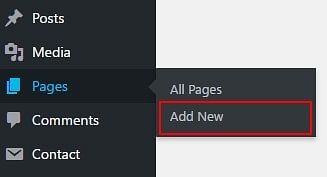
2. The next thing to do is come up with a relevant title for that page, so you can go with “Disclaimer” or “Legal information” or “Legal disclaimer” etc. If you have already written your disclaimer, copy that disclaimer into this section you opened in a previous step. If not, you need to start writing, until it is complete.
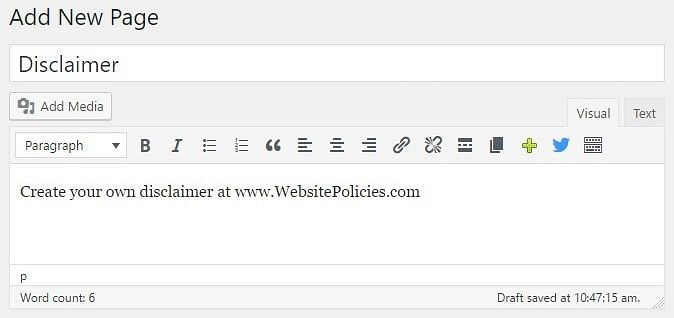
3. When this is done, click “Publish” or to check just how it is going to look prior to being live, you need to click on the “Preview” button. Copy the URL for your new page for our next step.
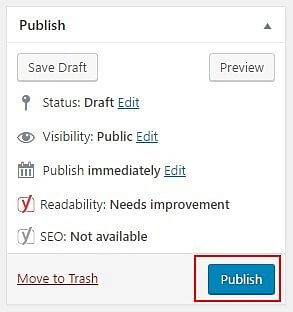
4. If your footer uses menus, you will need to return to the dashboard and click on “Appearance” and then click on “Menus.” Then you need to select the footer menu which you are going to see in the upper-right corner. Next to the disclaimer page’s title, you will see a box that you should again click on, select “Add Page” and then go to “Save Menu”.
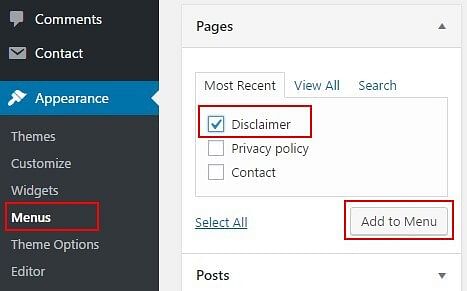
Blog disclaimer examples
Finally, let us go over some examples of a blog disclaimer and discuss them. Within these examples, you might find inspiration for your disclaimer and you are going to get a better idea of how it is done.
“Expressed views” disclaimer
These types of disclaimers are commonly seen on blogs or any other online media publications for that matter. We have already discussed this type of disclaimer throughout the text, as it has the purpose of informing readers that the views, and thoughts expressed in the content belong solely to the author.
So, people who endorse or critique a certain product or do something similar, have it in their best interest to state that the content is based on their personal opinion.
These disclaimers can be delivered as a short and to-the-point sentence, or they can be written in more of an ironic or even funny tone.

“No responsibility” disclaimer
These are also referred to as disclaimers of liability and they are commonly found on business websites. Basically, the disclaimer is there to prevent your business from being held responsible or liable, in the event something goes wrong and is caused by a user of your website or app for example.
These are also found in the end-user license agreement, in order to make users realize the company will not be held responsible for any damages that arise from the use of an application.

“Past performance” disclaimer
A disclaimer used by investment companies or financial marketers, due to the constant ebb and flow of the economy and ever-changing asset values.
As its name suggests, the disclaimer informs the users that past performance does not affect or guarantee future results. Here is an example of such a disclaimer.

“Use at your own risk” disclaimer
If you are sharing recipes or DIY tutorials, or medical tips and tricks in your articles, then it would be in your best interest to include a “Use at your own risk” disclaimer on your website.
Basically, if people who actively follow your advice can end up in a tricky situation, due to different conditions, this disclaimer is your get-out-of-lawsuit-free card.

“Errors and omissions” disclaimer
It is impossible to know everything, but that shouldn’t stop you from sharing what you know. However, it is fair to say that the information you provide is prone to errors and omissions and to include this type of disclaimer.
It clears you from taking responsibility should someone act upon the information you provide, and more importantly, it prevents “alternative facts” from spreading all over the world.

“Fair use” disclaimer
Whenever you use something under the Fair Use Act you need to include a fair use disclaimer.
This will help you avoid falling prey to copyright infringement issues because the Fair Use Act allows you to use, cite or incorporate content from another author, as long as you are explicitly using it for news reporting, research purposes, teaching, commentary, or criticism.
Movie reviews or using a section of a published book for educational purposes are usually instances where people are protected by the Fair Use Act.

“Investment” disclaimer
If you want to provide readers with financial advice in your content, then you are definitely going to need an Investment disclaimer. In this disclaimer, you tell your users right from the get-go that you don’t have any insider information, and that you are not a professional investment advisor, broker or dealer.
The same goes if you are simply running a platform that provides publicly available information, and analysis or materials that help someone make an investment decision.
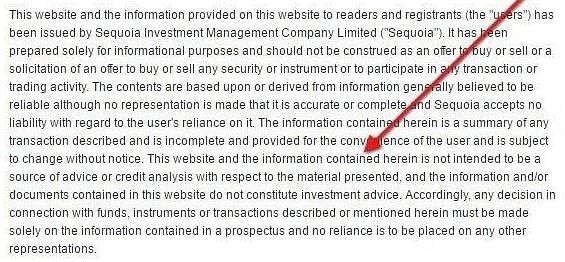
“Copyright notice” disclaimer
You should use this to make people aware that the content and intellectual property rights on your website belong to you.

“Email” disclaimer
You usually see this in the footer section of an email along with a signature, but unlike the rest of these disclaimers, it can’t completely absolve you or protect you from avoiding legal issues. However, it does come in handy, if the emails are confidential and you want to prevent your users from sharing them.

These were just some examples of blog disclaimers and you can definitely use them as inspiration when crafting one for your own blog. Alternatively, you may take an easier approach and use our professional blog disclaimer generator to create an attorney-drafted disclaimer custom-tailored to your blog in minutes.



